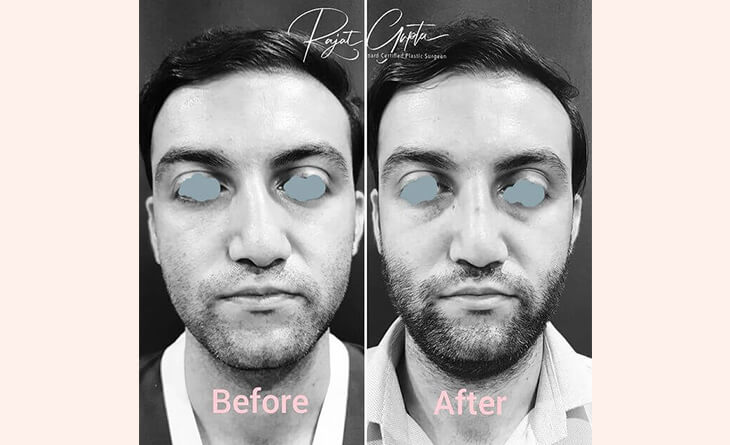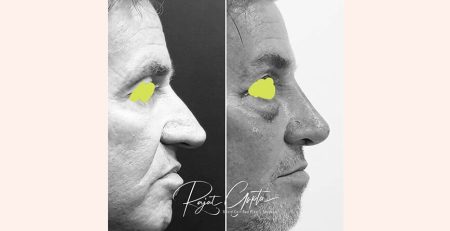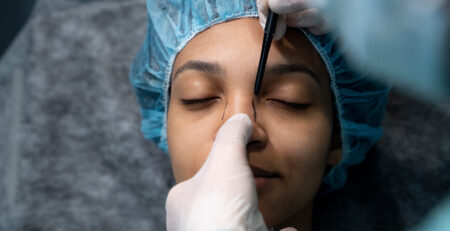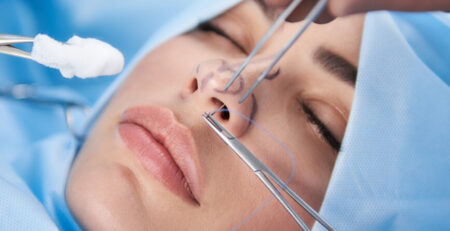What Are Rhinoplasty Grafts and Why Are They Important?
When planning for rhinoplasty surgery in Delhi, one term you might often hear from your cosmetic surgeon is “grafts.” But what exactly are rhinoplasty grafts, and why do they matter so much? Simply put, grafts are small pieces of cartilage or sometimes other materials that surgeons strategically place during a nose job surgery to support, enhance, or reshape the nose. They play a vital role in both functional and aesthetic results, making them a crucial element of modern rhinoplasty techniques.
When planning for rhinoplasty surgery, one term you might often hear from your cosmetic surgeon is “grafts.” But what exactly are rhinoplasty grafts, and why do they matter so much? Simply put, grafts are small pieces of cartilage or sometimes other materials that surgeons strategically place during a nose job surgery to support, enhance, or reshape the nose. They play a vital role in both functional and aesthetic results, making them a crucial element of modern rhinoplasty techniques.
What Are Rhinoplasty Grafts?
Rhinoplasty grafts are typically made from cartilage taken from the patient’s own body. The most common sources are the nasal septum, ear (conchal cartilage), or rib (costal cartilage). In certain complex cases, synthetic materials might also be used, but natural grafts remain the gold standard due to their better integration and lower risk of rejection.
When you undergo rhinoplasty surgery, grafts can provide additional support where tissue may be weak or help redefine the nose’s shape for a more harmonious facial balance. Without them, the nose might collapse, look irregular, or even cause breathing problems.

Have questions or want to get started? We are ready to help you with a smile!
Why Are Grafts Critical in Rhinoplasty Surgery?
Grafts serve both structural and cosmetic purposes. Structurally, they strengthen the nasal framework, especially in revision nose job surgeries where previous tissue has been compromised. Cosmetically, they sculpt the nose to achieve the desired shape. This dual role makes grafts indispensable in modern rhinoplasty.
For patients who visit a cosmetic surgeon in Delhi, especially someone experienced like Dr. Rajat Gupta, understanding the function of grafts reassures them that every detail is meticulously handled for the best possible outcome. Whether the goal is a subtle refinement or a major reconstruction, grafts often determine the durability and beauty of the results.
Different Types of Rhinoplasty Grafts
Every nose is unique, and so is every rhinoplasty surgery. Surgeons carefully choose graft types based on the patient’s anatomy, surgical goals, and desired aesthetic outcome. The proper selection and placement of grafts can be the defining factor between an average and an outstanding result in rhinoplasty surgery. Let’s dive deeper into the major types of grafts used during a nose job surgery:
- Spreader Grafts: These are thin, rectangular pieces of cartilage placed between the septum and the upper lateral cartilages. In rhinoplasty surgery, spreader grafts help widen the internal nasal valve, which is crucial for improving breathing function. A cosmetic surgeon in Delhi often uses spreader grafts to enhance both nasal airflow and the smoothness of the nasal bridge. Especially after dorsal hump reduction in nose job surgery, spreader grafts maintain structural integrity and prevent the middle part of the nose from collapsing.
- Columellar Strut Grafts: These grafts are strategically positioned between the medial crura of the lower lateral cartilages, essentially sitting between the nostrils. Their primary function is to support and project the nasal tip. A cosmetic surgeon in Delhi might recommend columellar strut grafts during rhinoplasty surgery if you desire a more defined and lifted nasal tip, creating a balanced, aesthetically pleasing profile post nose job surgery.
- Alar Batten Grafts: Alar batten grafts are placed along the sidewalls of the nose to reinforce weakened or collapsed nostrils. This type of graft becomes especially important in patients with nasal valve collapse, a common cause of breathing difficulty. During rhinoplasty surgery, using alar batten grafts ensures that the nose not only looks better but also functions properly, making them an essential tool in many nose job surgeries performed by a skilled cosmetic surgeon in Delhi.
- Shield Grafts: Named for their shield-like shape, these grafts are used specifically to enhance the definition and projection of the nasal tip. When added during rhinoplasty surgery, shield grafts offer greater tip refinement and sharper definition, helping create a more sculpted and harmonious nasal appearance. Patients often seek nose job surgery for a more elegant tip, and shield grafts are one of the go-to solutions.
- Septal Extension Grafts: These are one of the most powerful grafts in rhinoplasty surgery. Septal extension grafts attach to the nasal septum and extend outwards to control the tip’s length, rotation, and support. They offer unmatched stability and allow precise shaping of the nose during a nose job surgery. A board-certified cosmetic surgeon in Delhi like Dr. Rajat Gupta often utilizes septal extension grafts to address complex structural concerns and create enduring, beautiful results.
The art and science of using these grafts during rhinoplasty surgery require a profound understanding of facial aesthetics, nasal anatomy, and advanced surgical techniques. Every nose job surgery is a blend of structure, symmetry, and subtlety, and the thoughtful use of grafts plays a pivotal role in achieving a result that is both naturally beautiful and functionally sound.
Whether you’re considering rhinoplasty surgery for aesthetic enhancement or functional improvement, understanding the different types of grafts can help you have informed, meaningful discussions with your cosmetic surgeon in Delhi.
Autografts vs. Allografts vs. Synthetic Implants
In rhinoplasty surgery, grafts can be classified based on their source. Here’s a clear comparison:
| Type of Graft | Source | Features |
| Autografts | Harvested from the patient’s own body | Best integration, lowest risk of complications, preferred by surgeons |
| Allografts | Derived from processed donor tissue | Rarely used, safe but less ideal than autografts |
| Synthetic Implants | Made from materials like silicone or Gore-Tex | Convenient, but higher risk of infection or rejection compared to autografts |
Choosing the right graft material during rhinoplasty surgery plays a crucial role in the surgery’s success, which is why consulting an experienced cosmetic surgeon in Delhi like Dr. Rajat Gupta is essential.
How Grafts Influence the Outcome of Your Nose Job Surgery?
The final look, strength, and functionality of the nose after rhinoplasty surgery depend significantly on how well the grafts are placed and integrated. Poorly planned grafting can lead to visible irregularities, breathing difficulties, or the need for revision surgery.
Grafts help achieve:
- Improved nasal airflow
- Enhanced nasal tip definition
- Straightening of a deviated nose
- Better symmetry
- Long-lasting structural support
Patients seeking nose job surgery often prioritize aesthetic goals, but functionality is equally critical. That’s why partnering with a cosmetic surgeon in Delhi who thoroughly understands grafting techniques is essential for lasting success.
Common Concerns About Rhinoplasty Grafts
Many patients worry about pain, scars, or complications associated with cartilage harvest. Fortunately, modern techniques are minimally invasive. For example, when cartilage is taken from the ear, the incision is hidden behind it. Rib cartilage harvest might involve a small scar under the breast fold, easily concealed.
Additionally, grafts used in rhinoplasty surgery do not alter the donor site’s appearance or function. Surgeons like Dr. Rajat Gupta are highly skilled in ensuring a smooth recovery with minimal discomfort and outstanding results.
Recovery and Longevity: What to Expect
Post-operatively, swelling and bruising are normal, but specific aftercare practices help grafts heal well and settle naturally. Full results from nose job surgery, including the final integration of grafts, may take up to a year.
The good news? Once healed, grafts become part of your nose’s natural structure, offering permanent support. The stability they provide means your rhinoplasty surgery results can last a lifetime with proper care.
Final Word – The Importance of Rhinoplasty Graphs
Rhinoplasty grafts are much more than technical jargon – they are foundational to achieving stunning, functional, and lasting results in rhinoplasty surgery. Their careful selection, placement, and integration require the experience and artistic vision of a top-tier cosmetic surgeon in Delhi.
If you’re considering nose job surgery and want results that are both beautiful and enduring, you deserve the expertise of a trusted specialist. Dr. Rajat Gupta, with his unparalleled skill, compassionate approach, and extensive experience in rhinoplasty surgery, is here to help you achieve your dream look with confidence.
Book your consultation with Dr. Rajat Gupta today — because your nose deserves the artistry, precision, and personalized care of one of Delhi’s finest cosmetic surgeons!
Dr. Rajat Gupta
MBBS, MS, DNB(Gen. Surg.),
DNB (Plastic Surgery)
Dr. Rajat Gupta is a board certified plastic surgeon in India with 15 years of experience to back his expertise in the domain of aesthetic surgeries.
Having completed his training from Maulana Azad Medical College and equipped with a thorough understanding of aesthetic needs of people, Dr. Gupta strives to offer the best remedies and cosmetic procedures outfitted with the latest technology to the aspirants in India and across the globe. To book an appointment, call: +91-9251711711 or email: contact@drrajatgupta.com













